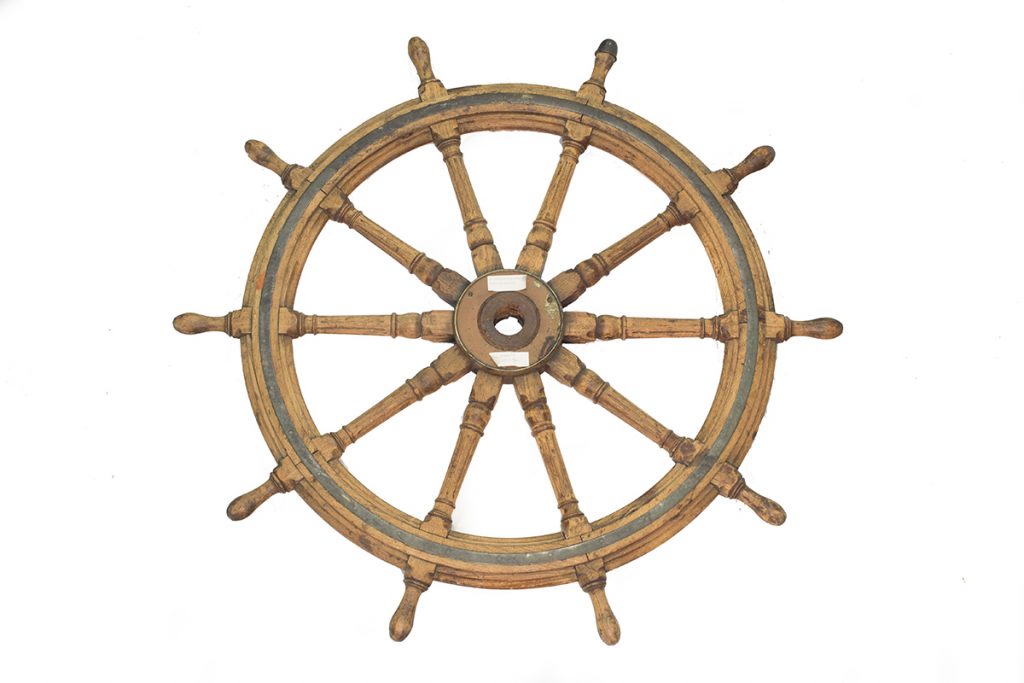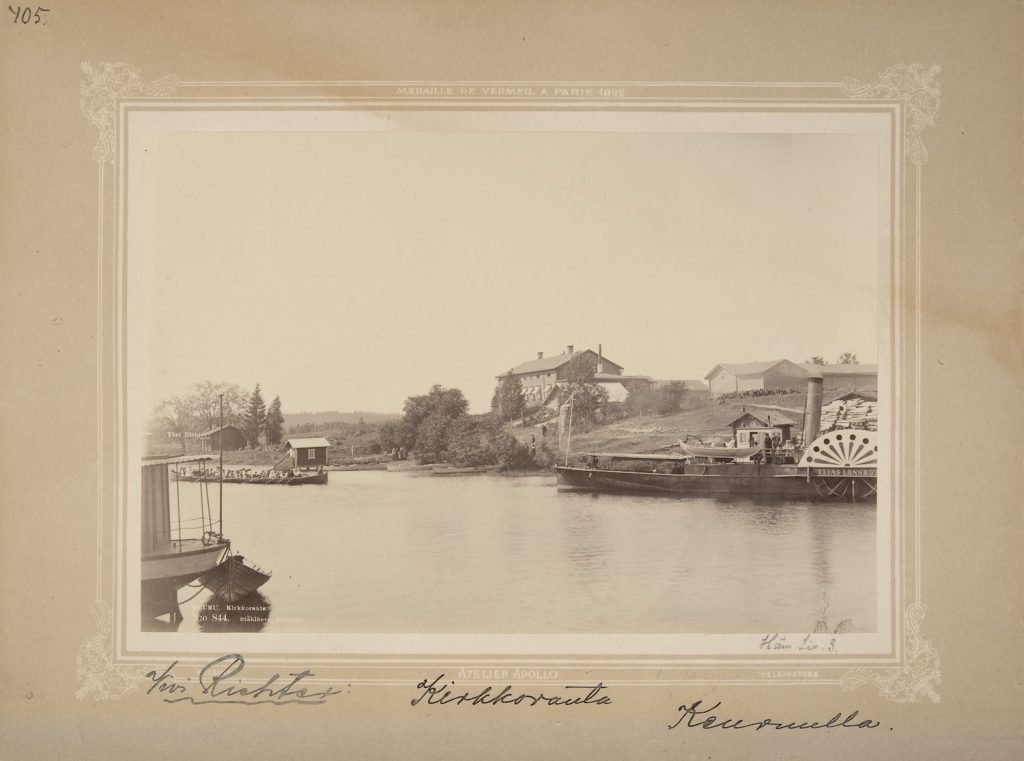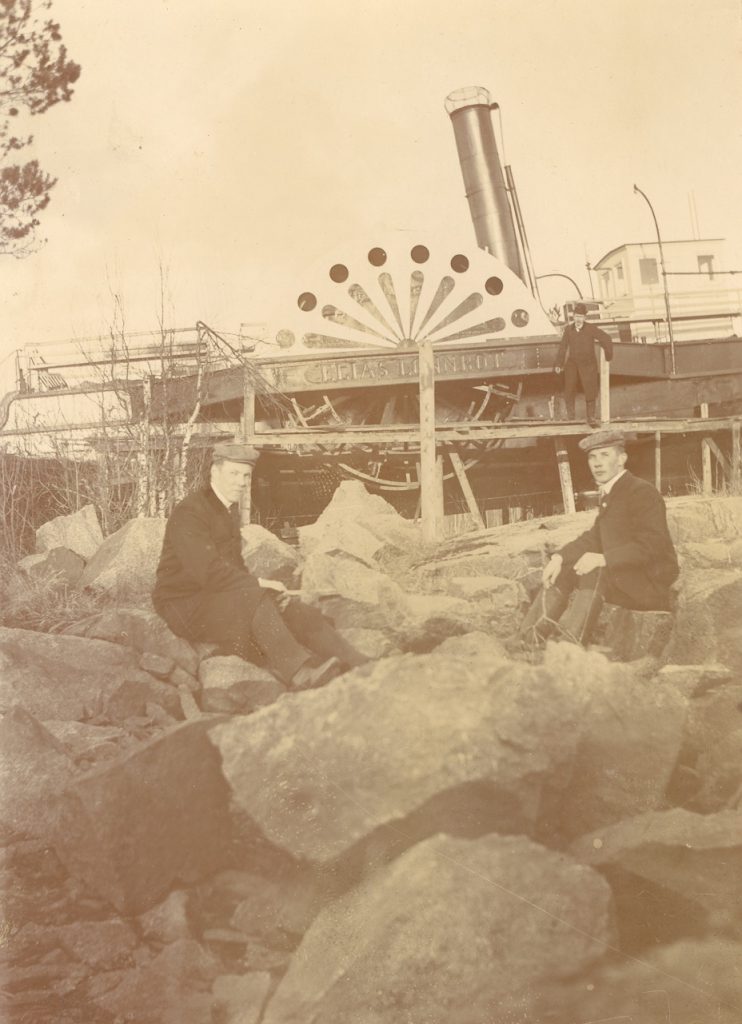The Helm of Elias Lönnrot
FEBRUARY 2022
Serlachius Museums collection comprise the helm of the paddle steamer Elias Lönnrot. Bought by G. A. Serlachius in 1890, the steamer ship was mainly used to transport timber, but it also took part in passenger traffic.
”Day before yesterday, the (passengership) Mänttä accompanied Tampere-based old steamer boat Elias Lönnrot to Vilppula where its new owner mill proprietor G. A. Serlachius aims to relocate it to sail Lake Keurusselkä.” (News Paper Aamulehti 31 Oct, 1890.)
G. A. Serlachius paid 10 000 Fmk for the steamer Elias Lönnrot that Tampereen Konepaja had constructed in 1865. The ship’s name referred to the creator of Finnish national epic Kalevala who had been working as a home teacher of the ship’s first owner Adolf Törngren’s family at Laukko Manor.
During its first years, the steamer Elias Lönnrot participated in passenger traffic on the route Tampere–Lempäälä–Hämeenlinna. On completion of the railway, the vessel was relocated to Lake Näsijärvi. Before the paddle steamer’s transfer operation to Lake Keurusselkä it had been positioned at Onkiniemi workshop shipyard for reparation as it had run on a rock in September 1890 while transporting passengers from Tampere to Kuru.
Elias Lönnrot started its service on Lake Keurusselkä in summer 1892. At that time, also a wood-framed steamer Keuru, co-owned by G. A. Serlachius, was sailing on the lake, whereas downstream from Mäntänkoski Rapids sailed small steamer Yrjö owned by Serlachius.
Typical for its era, Elias Lönnrot was a mixed vessel that at times towed a pram or a raft of logs and at times transported passengers. Many became familiar with the steamer on their church trips. On 30 December 1984 in the News Paper Keskisuomalainen, Helga Virtanen reminisced her childhood church trip from Mänttä to Keuruu at Midsummer during 1910s. They had made stops on their way to pick up more passengers. Most of the time the captain had spoken Swedish except that the words of command he announced in Finnish in the brass horn. The vessel had a restaurant that served coffee, among others. The children were able to hava a taste of lemonade.
Elias Lönnrot had also some unpleasant events in its past. In 1913, the captain of the ship had drowned. The accident happened when the vessel had been towing a large raft of timber on Lake Keurusselkä about one kilometre away from Mänttä. The captain had been checking the lure he had been pulling behind the vessel and he fell into the water. After having sustained hard blows by the paddles of the ship, he could not get out of the water and was left under the large raft.
According to the logbooks of the vessel from the years 1923–1924, the paddle steamer Elias Lönnrot seems in its old age to have been concentrating mainly on transport of timber. In summer 1923 service season started on 23 may and ended on 20 July. At that time the vessel had a crew of five men. During the summer, altogether 494 cubic meters of firewood was loaded from Sassi in Mänttä to supply the vessel. The ship operated around Lake Keurusselkä and transported rafts of timber, rafts of chopped blocks, loose floating rafts of blocks surrounded by booms, prams, Rosenlew pontoons, one raft-winding boat and “some gents on a jaunt” from Mänttä to Tuulisaari Island.
In timber transportation, traffic on water remained important in Finland until 1960s even though the proportion of inland water traffic in passenger and other freight transport started to decline in the 1920s.
In the end, the paddle steamer Elias Lönnrot was scrapped in the 1920s. It was one of the last steam-powered paddle vessels in Finland. The story goes that a worker at G.A. Serlachius Oy rescued the ship’s helm and put it in the attic of the company’s central warehouse. In 1984, K. E. Lindblad who was active in preserving local tradition in Mänttä, put the helm on show in Perinnetalo Traditional house. Nowadays the helm belongs to the Serlachius Museums’ collections.
Since 1986, a paddle ship entitled Elias Lönnrot has been running on Lake Keurusselkä once again, this time powered by diesel. The earlier namesake has served as a model for the ship.
Katri Tolonen
Curator
Sources:
Kivinen, Jussi 2016: Sisävesien mikrotonnisto. Pienet höyrylaivat Suomen ja erityisesti Kainuun sisävesiliikenteessä 1870-luvulta 1960-luvulle. Jyväskylän yliopisto.
Lehdet: Aamulehti 1890–1893, 3.4.1908, 23.7.1913; Hämäläinen 23.7.1874; Keskisuomalainen 30.12.1984; Suometar 10.6.1865; Tampereen Sanomat 1890.
Serlachius G. A. Oy, Metsäosasto – Laivapäiväkirjat; Suomen Elinkeinoelämän keskusarkisto.
Tuomi-Nikula, Jorma & Koskinen, Erkki 1986: Elias Lönnrot. Suomen viimeinen siipirataslaiva. Keurusprint Oy, Keuruu.




